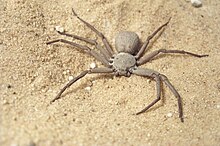| Six-eyed sand spiders | |
|---|---|

| |
| Female Sicarius | |
| Scientific classification | |
| Domain: | Eukaryota |
| Kingdom: | Animalia |
| Phylum: | Arthropoda |
| Subphylum: | Chelicerata |
| Class: | Arachnida |
| Order: | Araneae |
| Infraorder: | Araneomorphae |
| Family: | Sicariidae |
| Genus: | Sicarius Walckenaer, 1847 |
| Species | |
|
21, see text | |
Sicarius is a genus of recluse spiders that is potentially medically significant to humans. It is one of three genera in its family, all venomous spiders known for a bite that can induce loxoscelism. They live in deserts and arid regions of the Neotropics, and females use a mixture of sand and silk when producing egg sacs. The name is Latin for assassin.
Description
Sicarius spiders can grow up to 1 to 2 inches (25 to 51 mm) long, and have six eyes arranged into three groups of two (known as "dyads"). Physically, they resemble crab spiders and members of the Homalonychus genus. They lack the characteristic violin-shaped marking of the more well-known members of its family, Sicariidae the recluse spiders.
They can live for a very long time without food or water. Some can live for up to fifteen years, making them among the longest-lived spiders, behind the trap-door spiders and tarantulas, many known to live for twenty to thirty years. The oldest recorded spider is Number 16, a trap-door spider killed by a parasitic wasp at forty-three years old.
Venom components and effects
Like all recluse spiders, these produce a dermonecrotic venom that contains sphingomyelinase D, an enzyme in the sphingomyelin phosphodiesterase family. It is somewhat unique to them, otherwise only found in a few pathogenic bacteria. The venom causes bleeding and damage to many organs of the body, though only S. ornatus and a few others have been proven to be extremely toxic on the order of Hexophtalma hahni or several other African sand spiders. It has also recently been proven that Sicarius thomisoides contains active sphingomyelinase D, very similar to that of Loxosceles laeta and Sicarius ornatus, and that its bite can cause serious damage in humans.
Taxonomy
This genus was erected by Charles Athanase Walckenaer in 1847 with the single species, S. thomisoides. In 2017, the number of species decreased after a phylogenetic study showed that the South African species formerly included here were actually distinct, instead belonging to the genus Hexophthalma.
It is one of only three genera in its family, and is placed in the same subfamily as Hexophthalma:
| Sicariidae |
| ||||||||||||
Species
As of March 2020 it contains twenty-one species, found in South America:
- Sicarius andinus Magalhães, Brescovit & Santos, 2017 – Peru
- Sicarius boliviensis Magalhães, Brescovit & Santos, 2017 – Bolivia, Peru, Brazil, Paraguay
- Sicarius cariri Magalhães, Brescovit & Santos, 2013 – Brazil
- Sicarius crustosus (Nicolet, 1849) – Chile
- Sicarius diadorim Magalhães, Brescovit & Santos, 2013 – Brazil
- Sicarius fumosus (Nicolet, 1849) – Chile
- Sicarius gracilis (Keyserling, 1880) – Ecuador, Peru
- Sicarius jequitinhonha Magalhães, Brescovit & Santos, 2017 – Brazil
- Sicarius lanuginosus (Nicolet, 1849) – Chile
- Sicarius levii Magalhães, Brescovit & Santos, 2017 – Chile, Argentina
- Sicarius mapuche Magalhães, Brescovit & Santos, 2017 – Argentina
- Sicarius ornatus Magalhães, Brescovit & Santos, 2013 – Brazil
- Sicarius peruensis (Keyserling, 1880) – Peru
- Sicarius rugosus (F. O. Pickard-Cambridge, 1899) – El Salvador, Nicaragua, Costa Rica
- Sicarius rupestris (Holmberg, 1881) – Argentina
- Sicarius saci Magalhães, Brescovit & Santos, 2017 – Brazil
- Sicarius thomisoides Walckenaer, 1847 (type) – Chile
- Sicarius tropicus (Mello-Leitão, 1936) – Brazil
- Sicarius utriformis (Butler, 1877) – Ecuador (Galapagos)
- Sicarius vallenato Cala-Riquelme, Gutiérrez-Estrada, Flórez-Daza & Agnarsson, 2017 – Colombia
- Sicarius yurensis Strand, 1908 – Peru, Chile
In synonymy:
- S. deformis (Nicolet, 1849) = Sicarius fumosus (Nicolet, 1849)
- S. irregularis (Mello-Leitão, 1940) = Sicarius rupestris (Holmberg, 1881)
- S. minoratus (Nicolet, 1849) = Sicarius thomisoides Walckenaer, 1847
- S. nicoleti (Keyserling, 1880) = Sicarius thomisoides Walckenaer, 1847
- S. patagonicus Simon, 1919 = Sicarius rupestris (Holmberg, 1881)
- S. rubripes (Nicolet, 1849) = Sicarius thomisoides Walckenaer, 1847
- S. terrosus (Nicolet, 1849) = Sicarius thomisoides Walckenaer, 1847
Transferred to Hexophthalma
- Sicarius albospinosus = Hexophthalma albospinosa (Purcell, 1908)
- Sicarius damarensis = Hexophthalma damarensis (Lawrence, 1928)
- Sicarius dolichocephalus = Hexophthalma dolichocephala (Lawrence, 1928)
- Sicarius hahni = Hexophthalma hahni (Karsch, 1878) (also = Sicarius testaceus)
- Sicarius spatulatus = Hexophthalma spatulata (Pocock, 1900)
See also
References
- "World's Oldest Known Spider Dies at 43, With Lesson for Us". National Geographic. 30 April 2018. Retrieved 2020-04-11.
- ^ Magalhães, I.L.F.; Brescovit, A.D. & Santos, A.J. (2017). "Phylogeny of Sicariidae spiders (Araneae: Haplogynae), with a monograph on Neotropical Sicarius". Zoological Journal of the Linnean Society. 179 (4): 767–864. Retrieved 2018-07-20.
- Arán-Sekul, Tomás; Perčić-Sarmiento, Ivanka; Valencia, Verónica; Olivero, Nelly; Rojas, José M.; Araya, Jorge E.; Taucare-Ríos, Andrés; Catalán, Alejandro (November 2020). "Toxicological Characterization and Phospholipase D Activity of the Venom of the Spider Sicarius thomisoides". Toxins. 12 (11): 702. doi:10.3390/toxins12110702. PMC 7694614. PMID 33171968.
- Walckenaer, C. A. (1847), "Dernier Supplément", in Walckenaer, C. A. (ed.), Histoire naturelles des Insects
- Gloor, Daniel; Nentwig, Wolfgang; Blick, Theo; Kropf, Christian (2020). "Gen. Sicarius Walckenaer, 1847". World Spider Catalog Version 20.0. Natural History Museum Bern. doi:10.24436/2. Retrieved 2020-04-11.
External links
- Arachnology Home Pages: Loxosceles: Recluse spiders
- Biodiversity Explorer: Family Sicariidae (photos of Sicarius and Loxosceles)
- Platnick, N. I. 2003. World Spider Catalog.
- Vetter, R. 2003. "Causes of Necrotic Wounds other than Brown Recluse Spider Bites".
- Vetter, R. 2003. "Myth of the Brown Recluse: Fact, Fear, and Loathing".